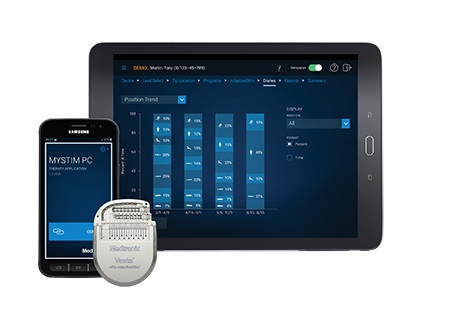The Medtronic Advantage Over Pain
The FDA grants approval for Vanta™, the next generation recharge-free neurostimulator at Medtronic
For some patients with chronic pain, performing the most basic tasks can be incredibly challenging. And that includes taking the time to recharge a medical device designed to deliver relief.
But now, a new treatment option is on its way to the market.
Recently, the FDA approved Vanta™, a high performance, recharge-free implantable neurostimulator (INS) made by Medtronic. With a compact design and a lifespan that can be optimized up to 11 years, Vanta™ is designed to give patients a new choice in highly personalized pain relief.

“Not every patient with chronic, intractable pain is an ideal candidate for a rechargeable device, so the Vanta™ INS represents a welcome addition to my portfolio of available treatment options,” said Krishnan Chakravarthy, M.D., Ph.D., a San Diego-based interventional pain management physician. “The extended battery life, broad MRI compatibility and personalized relief through AdaptiveStim™ technology allow for a more hassle-free experience and greater freedom for my patients as we manage their chronic pain.”
Personalized programming
The approval of the Vanta™ neurostimulator marks an important milestone in the company’s quest to deliver effective spinal cord stimulation treatment to patients suffering from chronic pain stemming from conditions such as unsuccessful back surgeries, degenerative disk disease, and failed back surgery syndrome.
How?
By tapping the power of Medtronic’s proprietary AdaptiveStim™ technology for personalized pain relief, Vanta™ adapts to the patient’s movement or body position using a built-in accelerometer. One study showed that 88.7% of patients reported better pain relief using AdaptiveStim™ therapy.1
“The truth is that stimulation within the spinal cord isn't just in a static environment,” Chakravarthy says. “Patients are moving. Patients are doing things. Ultimately, that part of it rests on developing a therapy that's really looking at all of these different measurements and adapting that therapy to the changes that patients feel

Vanta™ device users will also benefit from its advanced battery chemistry, which provides a 10% increase in longevity compared to PrimeAdvanced™, the previous generation recharge-free neurostimulator made by Medtronic. It is also 20% smaller than PrimeAdvanced™. At comparable settings, the Vanta neurostimulator offers nearly twice the device life than competitive primary cell devices. 2,3
“Medtronic has a rich and long history of designing and engineering industry-leading battery technology and it’s something in which we take a lot of pride, ” said Charlie Covert, vice president and general manager, Pain Therapies within the Neuromodulation business at Medtronic. “And with Vanta™, we’re delivering technology that has the kind of longevity our clinicians and patients have asked for in spinal cord stimulation therapy.”
Broadening the portfolio
Within the spinal cord stimulation market, Medtronic has been winning back market share in the rechargeable segment with Intellis™, a high performance rechargeable neurostimulator. In the recharge-free segment, Medtronic is currently occupying a low market share – and Covert and his team recognize the growth potential that the Vanta™ INS represents, as they seek to bring relief to many patients in the United States. Vanta™ will complement Intellis™ providing patients and clinicians with comprehensive choices to alleviate pain.
Clinicians and their patients wishing to trial the Vanta™ neurostimulator may also take advantage of CareGuidePro™, a mobile application and web portal that serves as a virtual guide for patients throughout their Medtronic spinal cord stimulation therapy journey.

CareGuidePro™ is currently in limited commercial release with a full launch expected later this summer.
Covert said the integration with CareGuidePro™ is another feature of Vanta™ that enables it to deliver a tailored therapy experience.
“We are committed to delivering innovative solutions that meets the needs of every patient,” Covert said. “For those who prefer or require a recharge-free device, I believe the Vanta neurostimulator offers the best hardware and features available today. We are pleased to offer this solution, which is now part of the strongest and broadest overall portfolio in this market.”
1. Schultz D, Webster L, Kosek P, et al. Sensor-driven position-adaptive spinal cord stimulation for chronic pain. Pain Physician. 2012;15(1):1-12.
2. Settings used from Abbott’s Proclaim™ clinician manual. Nominal settings 12 hours per day: 50-Hz frequency, 225-μs pulse width, and 5-mA amplitude at 500-ohms impedance. Compared to flagship model 3660.
3. Settings from Boston Scientific’s Alpha™ IFU. Programmed at 4.1mA, 280us, 40 Hz, 1 area, 730 Ohms, 2 contacts.
Clinical and Economic Evidence Driving Patient-Centered Care
Read How: Meaningful Innovation
L001-060421
SPINAL CORD STIMULATION BRIEF SUMMARY
INDICATIONS Spinal cord stimulation (SCS) is indicated as an aid in the management of chronic, intractable pain of the trunk and/or limbs-including unilateral or bilateral pain.
CONTRAINDICATIONS Diathermy - Energy from diathermy can be transferred through the implanted system and cause tissue damage resulting in severe injury or death.
WARNINGS Sources of electromagnetic interference (e.g., defibrillation, electrocautery, MRI, RF ablation, and therapeutic ultrasound) can interact with the system, resulting in unexpected changes in stimulation, serious patient injury or death. An implanted cardiac device (e.g., pacemaker, defibrillator) may damage a neurostimulator, and electrical pulses from the neurostimulator may cause inappropriate response of the cardiac device.
PRECAUTIONS Safety and effectiveness has not been established for pediatric use, pregnancy, unborn fetus, or delivery. Avoid activities that put stress on the implanted neurostimulation system components. Recharging a rechargeable neurostimulator may result in skin irritation or redness near the implant site.
ADVERSE EVENTS May include: undesirable change in stimulation (uncomfortable, jolting or shocking); hematoma, epidural hemorrhage, paralysis, seroma, infection, erosion, device malfunction or migration, pain at implant site, loss of pain relief, and other surgical risks.
Refer to www.medtronic.com for product manuals for complete indications, contraindications, warnings, precautions and potential adverse events. Rx only. Rev 0119
